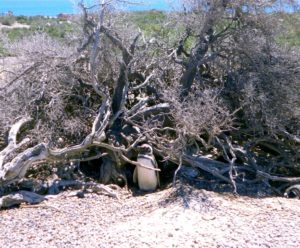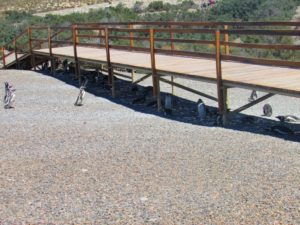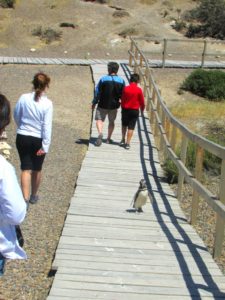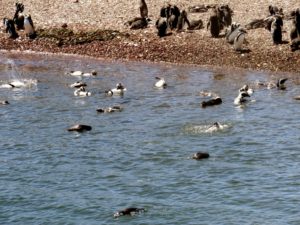21 Aug Argentina — The Penguins of Patagonia
Like a lot of us, I’m a sucker for charismatic mega-fauna, especially when that megafauna is penguins. The conscientious way they stand guard over their chicks shows them off as better parents than I ever was. Heck, it makes them better parents than even Bill Cosby used to be. They swim longer distances in the ocean than Diana Nyad and they’re cuter than Sally Fields and Holly Hunter added together. Which is why Peggy and I wound up at Punta Tombo, a penguin preserve on the Peninsula Valdes which, itself, is a popsicle-shaped piece of Argentina jutting into the South Atlantic.
Until the Sixties, Punta Tombo was part of a working ranch, but it’s easy to see why that didn’t work out. The major resources of the place are thorny bushes, scrubby land and briny lakes that, even though they’re surrounded by ocean on three-and-a-half sides, tend to be below sea level. Its natural inhabitants are guanaco, armadillos, owls who live in holes in the ground and, recently, Magellanic penguins . . . which started arriving when the ranch went out of business.
Something like a million of them spend summers there, now, jostling together on three kilometers of beach. That’s a crowd, even by penguin standards. They stand in knots like spectators at the Rose Parade. They nest under every bush,

and there are lots of bushes. Some shade themselves beneath the boardwalks that are supposed to keep them separate from humans,

while others hop onto the boardwalks and stroll along, causing humans to stand in knots and wait for them to pass.

Along the beach, throngs of penguins plop into the ocean. Shoals of penguins already in the ocean porpoise through the waves and, then, pop back onshore when they can find a vacant place to pop onto.

Punta Tombo is the Daytona Beach of the penguin world and, since every female lays two eggs, the place becomes a lot more crowded as the eggs begin to hatch. If all the chicks returned as adults, it wouldn’t be long before there were so many penguins at Punta Tombo the earth would become lopsided and fall out of orbit. But they don’t, and it hasn’t. The truth is, fewer adults are returning than used to. Dee Boersma, professor of penguins from the University of Washington, is pretty clear on that point. The number of penguins at Punta Tombo is heading downhill.
She didn’t go off half-cocked about this. Professor Boersma spent thirty-seven years at Punta Tombo clipping bands onto the legs of chicks, then flipping over a million-or-so adult penguins the following year to check their bona fides. When she had the numbers in hand she went back to her trailer, consulted historical weather records, relevant penguin literature, mathematical tables, other luminaries in the world of penguinology, and thought long and hard about what was going on. Then she rechecked her facts, gathered her conclusions, and pointed her finger at the “climate-induced change” that forced “penguins to swim about 25 miles farther each day in search of food, which reduced their chance of survival.”
Since Punta Tombo is the biggest penguin colony in Argentina and climate change is an even bigger deal everywhere else, the news reverberated like the boom from Mount Krakatoa heard around the world and back again. Within hours, it had rung church bells as far away as the New York Times, the Los Angeles Times, the Voice of America, the Voice of Russia, the Christian Science Monitor, National Public Radio, Good Morning America, Bird-Watching Daily, and, undoubtedly, any number of other sanctuaries of learning I’ve not been invited into.
Professor Boersma knows her penguins. In fact, she’s such an expert that she’s achieved one of the few measures of genuine expertness that’s in our poor powers as humans to bestow. The beat-up old trailer she used during all those marathon penguin-banding isn’t at Punta Tombo anymore. Like Abraham Lincoln’s stove-pipe hat, it belongs to the ages, now, and is safely lodged in a museum. Who can argue with that kind of scientific accolade? Still, it seems to me there may be more to this disappearing-penguin business than we’ve been told.
To me the fact that penguins have to swim farther than they used to in order to find something to eat probably has something to do with the fact that there’s not as much krill as there once was. The thing is, nobody fishes for krill. As far as the rest of us know, even Japanese sushi fishermen don’t fish for krill. But, since Japanese do sometimes fish for minke, fin and humpback whales . . . and minke, fin and humpback whales eat lots of krill . . . every whale that winds up in a Japanese meat market for scientific purposes is one less whale out there depleting the krill supply. Which suggests to me that the drop-off in the krill population may have more to do with the moratorium on hunting whales than on anything else.
What the articles about fewer-penguins-as-leading-indicators-of-all-the-bad-stuff-that’s-going-to-happen-where-you-live get right, is that things really aren’t what they used to be. Fifty years ago Punta Tombo was a working ranch and there weren’t any penguins there at all. Once the place turned into a nature reserve penguins started popping out of the water, wriggling beneath bushes, building nests, raising families, congregating along boardwalks, swimming out to sea, inviting more penguins to come join them and, in a tick of the biological clock, what used to be a penguin-free beach changed into the largest penguin colony in Argentina.
And, even if not a single chick from this year’s hatching makes it back next year, there’ll still be a million more penguins at Punta Tombo than there were in 1946 when Professor Boersma was hatched. Which doesn’t seem like much of a decline to me.


No Comments